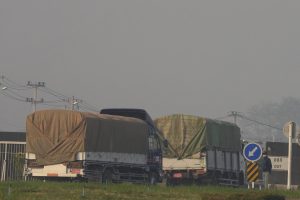Thailand has dispatched its first batch of aid along a humanitarian corridor to Myanmar that was recently established to assist civilian populations affected by the country’s metastasizing civil war.
According to The Associated Press, Thailand yesterday sent 10 trucks over the Mae Sot-Myawaddy border crossing, carrying around 4,000 packages of aid to three towns in Karen (Kayin) State. As the AP reported, “the parcels contained aid worth around 5 million baht ($138,000), mostly food, instant beverages and other basic items such as toiletries.”
In a send-off ceremony in Mae Sot marking the dispatch of the aid, Thai Vice Foreign Minister Sihasak Phuangketkeow said that the aid will benefit around 20,000 people in Na Bu village in Kawkareik district, and Thar Ma Nya and Paingkyon villages in Hpa-An district.
“We hope very much to see peace in Myanmar, internal issues certainly will be resolved by Myanmar themselves,” Sihasak said at the ceremony, which was also attended by junta officials from Karen State. “We want every side, all sides, to overcome their differences so that we can be led to reconciliation and peace in the near future.”
In late January, foreign ministers from the Association of Southeast Asian Nations (ASEAN), including a representative from the military administration that seized power in Myanmar in February 2021, endorsed Thailand’s initiative to establish the humanitarian corridor. Under the arrangement, the Thai and Myanmar Red Cross will deliver supplies to populations in need under the observation of the ASEAN Coordinating Center for Humanitarian Assistance on Disaster Management.
At the time, Sihasak expressed hope that the aid initiative could help open the way for dialogue between the military junta and its opponents, including the National Unity Government (NUG) and ethnic resistance groups. “Some kind of a dialogue process should begin maybe at least by the middle of the year,” Sihasak said.
The humanitarian corridor appears to reflect the more active policy toward Myanmar that the Thai government has adopted since Prime Minister Srettha took office in September. But the policy fails to transcend the limitations of ASEAN’s Five-Point Consensus peace plan, agreed three months after the coup, which calls for an immediate cessation to the violence in Myanmar and inclusive dialogue, as well as the delivery of humanitarian aid. The plan has stagnated, in large part because it treats the military administration as a willing party of peace, when its actions over the past three years suggest the exact opposite.
The humanitarian corridor is subject to the same limitations. By definition, any arrangement that involves the military junta can only take place within its chosen limits. The aid, which will be distributed by the Myanmar Red Cross, will almost certainly only benefit people in areas under the Myanmar military’s control, leaving the larger numbers of displaced populations in other areas without access to assistance.
In comments last week, Tom Andrews, the U.N. special rapporteur for human rights in Myanmar, said that delivering aid to the party most responsible for the country’s civil war was counterproductive and would not reach the populations most in need.
“That corridor puts humanitarian aid into the hands of the junta because it goes into the hands of the junta-controlled Myanmar Red Cross,” Andrews said, adding that the junta would use the resources, “for their own military strategic advantage.”
“The fact of the matter is, is that the reason that humanitarian aid is in such desperate need is precisely because of the junta,” he added. Andrews said the areas in desperate need are “conflict areas in which the junta has absolutely no influence or control whatsoever. So those are the areas we need to focus on.”
This is very much the preferred approach of the NUG, which earlier this month submitted to the Thai government a parallel humanitarian assistance proposal which would work with local civil society organizations to reach areas controlled by ethnic resistance armies.
“We welcome the cross-border assistance initiated by Thailand,” Dr. Win Myat Aye, the NUG’s minister for humanitarian affairs and disaster management said in an interview with The Irrawaddy. “But we are not very satisfied with the way it will be implemented. We don’t think it will be effective.”
Speaking to journalists after yesterday’s ceremony, Sihasak refused to comment which groups controlled the territory into which aid would be delivered.
“I don’t want to look at the issue as to which area is controlled by which side, let’s talk about the people who are affected. If there is an area where there is a need, then we have to take a look,” he said, BenarNews reported. “We are ready to work with everyone, as long as the focus is the people receiving the humanitarian aid.”
While many people will no doubt benefit from the humanitarian corridor as it is currently configured, there is a hard limit to how effective it can be, given that many of the country’s estimated 2.7 million displaced people, including some of those most in need, are located in contested areas or territories controlled by resistance groups. The ultimate test of the Thai approach is whether it can negotiate the distribution of aid in areas outside the military junta’s control – but as long as it relies on Naypyidaw’s consent, this outcome will remain very unlikely.

































